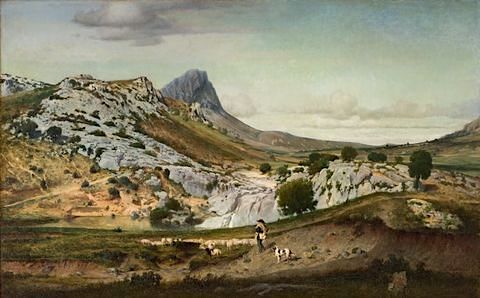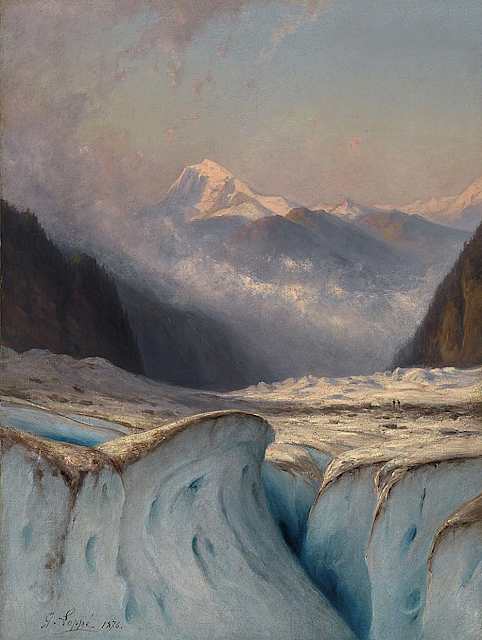ALEXANDRE CALAME (1810-1864)
Le Mont Rose (4 634 m)
Suisse- Italie
In Le Mont Rose, Huile sur toile 1843, 110x151cm, Musée d'art et d'histoire, Ville de Genève.
La montagne
Le mont Rose, (4 634 m) appelé depuis peu Massif du Mont-Rose, situé à la frontière entre la
Suisse et l'Italie, estle )lus haut sommet de Suisse à la Pointe Dufour. lI est aussi deuxième plus haut massif des Alpesaprès
celui du Mont-Blanc. Il est le quatrième plus haut sommet des Alpes. Le mont Rose comporte onze pics distincts : la
pointe Dufour : 4 634 m ; la pointe Dunant : 4 632 m ; le Nordend : 4
608 m ; la pointe Zumstein ou Zumsteinspitze : 4 562 m ; la Signalkuppe
ou pointe Gnifetti : 4 553 m ; la pointe Parrot : 4 434 m ; e
Ludwigshöhe : 4 342 m ; la tête Noire : 4 318 m ; la pyramide Vincent :
4 215 m ; le Balmenhorn : 4 167 m ; la pointe Giordani : 4 046 m.
Le peintre
Alexandre Calame, est un peintre et graveur suisse. Alexandre Calame, enfant, de
constitution chétive, s'est trouvé très tôt orphelin de père et a eu la
malchance de perdre un œil à la suite de coups reçus d'un camarade. Dès
l'âge de 15 ans, il commence à gagner sa vie dans la banque Diodati.
Dès
son enfance, il manifeste son talent artistique et, pour aider sa mère,
se met à peindre des vues suisses que les touristes achètent à titre de
souvenir. Faisant œuvre de mécènes, les patrons de la banque lui
permettent de fréquenter dès 1829 l'atelier du peintre genevois François
Diday. Il quitte bientôt son travail administratif pour se consacrer
entièrement à la peinture, et celle-ci rencontre rapidement du succès
En
1835, il ouvre une classe de dessin à Genève, en même temps qu'il
expose dans cette ville et à Paris. Le premier tableau qu'il présente à
Genève, Cours du Griffe, attire l'attention sur lui. Dès lors, il
peut vivre de son art, caractérisé par une fidélité jamais démentie à
un même sujet: la Nature, avec une prédilection pour le paysage alpestre
suisse. Il devient le maître incontesté du paysage alpin. En 1837, il
réalise son premier grand tableau, Orage sur la Handeck, qui lui
vaut la médaille d'or de l'Exposition des beaux-arts de la ville de
Paris (1841). En 1842, il reçoit la croix de la Légion d'honneur, à la
suite de l'exposition de ses œuvres, dont : le Mont Cervin, le Lac de Brienz, le Mont Blanc et le Mont Rose.
Ce dernier tableau est considéré comme son chef-d'œuvre et il marque
l'apogée de sa carrière. En 1853, Napoléon III lui achète pour 15 000
francs-or sa toile Le Lac des Quatre-Cantons, primée à l'Exposition
universelle1.
Calame fait de nombreux voyages dans l'Oberland, en Italie, en
Allemagne, en Belgique, à Londres et en Hollande mais sa santé devenant
de plus en plus précaire, ses campagnes de peintre paysagiste ne lui
étaient de moins en moins permises. En 1863, le peintre tombe malade et
son médecin lui conseille d'aller sous un ciel plus clément. Il alla
séjourner dans le Midi de la France, à Menton où il meurt le 17 mars
1864. L'artiste ne s'adonne pas seulement à la peinture mais également à
l'art de la lithographie et à celui de l'eau-forte. Selon l'historienne
d'art genevoise Valentina Anker, il existerait plus de 400 grands
tableaux, 250 aquarelles, 500 études, 670 dessins et croquis, plus de
100 sépias et une vingtaine de fusains.
________________________________________
2023 - Gravir les montagnes en peintureUn blog de Francis Rousseau

-%20The%20mattherhorn%20from%20%20Riffelsee-%20John%20Mitchell%20gallery%20London%20.png)












